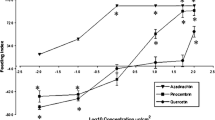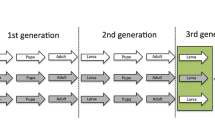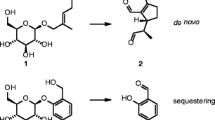Abstract
The chemical basis of feeding responses to the acceptable nonhost plantVigna sinensis (cowpea) by larvae ofManduca sexta was investigated using chemical isolation techniques directed by a novel chemosensory-based bioassay. The presence of feeding stimulatory and inhibitory compounds in leaves or leaf extracts was determined in a two-choice preference test using leaf disks or glass fiber filter paper disks laced with leaf extract as test substrate and filter paper disks laced with water as control. Larvae strongly prefer the control disks over leaf disks, indicating the presence of feeding inhibitory compounds in the leaf. An ethanol extract of both fresh and dried leaves neither stimulated nor inhibited feeding. The cause of this inactivity was examined by using larvae that respond strongly to either feeding stimulatory or inhibitory compounds due to selective chemosensory deprivation. Larvae having chemosensory organs remaining only on the maxillary palps are stimulated to feed by whole leaf disks and by the ethanol extracts. In contrast, larvae having only the medial and lateral maxillary sensilla styloconica and the epipharyngeal sensilla remaining are strongly inhibited by whole leaf disks and the ethanol extract of fresh leaves. Thus, the ethanol extract contains both feeding stimulatory and inhibitory compounds, which elicit opposite behavioral effects in unoperated larvae, therefore nullifying any stimulatory and inhibitory activity. These compounds can only be demonstrated by using discrimination-enhanced larvae in the choice tests. Further isolation of the feeding stimulatory principle inV. sinensis yielded two separate fractions of neutral compounds, suggesting at least two different chemicals belonging to two different classes: nonpolar and polar lipids. Feeding inhibitory chemicals have apparently polar properties because strong activity was found in the ethyl acetate and methanol extracts of dried leaves. The role of feeding stimulatory and inhibitory compounds in food selection ofM. sexta larvae is discussed.
Similar content being viewed by others
References
de Boer, G. 1991. Effect of diet experience on the ability of different larval chemosensory organs to mediate food discrimination by the tobacco hornworm,Manduca sexta.J. Insect Physiol. 37:763–769.
de Boer, G. 1992. Diet-induced food preference byManduca sexta larvae: Acceptable non-host plants elicit a stronger induction than host plants.Entomol: Exp. Appl. In press.
de Boer, G., andHanson, F.E. 1984. Food plant selection and induction of feeding preference among host and non-host plants in larvae of the tobacco hornworm,Manduca sexta (Lepidop-tera, Sphingidae).Entomol. Exp. Appl. 35:77–193.
De Boer, G., andHanson, F.E. 1987a. Differentiation of roles of chemosensory organs in food discrimination among host and non-host plants by larvae of the tobacco hornworm,Manduca sexta. Physiol. Entomol. 12:387–398.
De Boer, G., andHanson, F.E. 1987b. Feeding responses to solanaceous allelochemicals by larvae of the tobacco hornworm,Manduca sexta.Entomol. Exp. Appl. 45:123–132.
de Boer, G., andHanson, F.E. 1988. The role of leaf lipids in food selection by larvae of the tobacco hornworm,Manduca sexta.J. Chem. Ecol. 14:669–682.
Dethier, V.G. 1982. Mechanism of host-plant recognition.Entomol. Exp. Appl. 31:49–56.
Mitscher, L. A., Drake, S., Gollapudi, S.R., andOkwute, S.K. 1987. A modern look at folkloric use of anti-infective agents.J. Nat. Prod. 50:1025–1040.
Schoonhoven, L.M. 1972. Plant recognition by lepidopterous larvae.Symp. R. Entomol. Soc. London 6:87–99.
Schoonhoven, L.M. 1987. What makes a caterpillar eat? The sensory code underlying feeding behavior, pp. 69–97,in E.A. Bernays, R.F. Chapman, and J.J.G. Stoffolano Jr. (eds.). Perspectives in Chemoreception and Behavior. Springer-Verlag, Berlin.
Städler, E., andHanson, F.E. 1978. Food discrimination and induction of preference for artificial diets in the tobacco hornworm,Manduca sexta. Physiol. Entomol. 3:121–133.
Szentesi, A., andJermy, T. 1990. The role of experience in host plant choice by phytophagous insects, pp. 39–74,in E.A. Bernays (ed.). Insect-Plant Interactions, Vol. 2. CRC Press, Boca Raton, Florida.
Wrubel, R.P., andBernays, E.A. 1990. The relative insensitivity ofManduca sexta larvae to non-host plant secondary compounds.Entomol. Exp. Appl. 54:117–124.
Yamamoto, R.T., andFlowers, R.W. 1982. Feeding on non-host plants by the tobacco hornwormManduca sexta (Lepidoptera: Sphingidae).Fla. Entomol. 65:523–530.
Author information
Authors and Affiliations
Rights and permissions
About this article
Cite this article
De Boer, G., Schmitt, A., Zavod, R. et al. Feeding stimulatory and inhibitory chemicals from an acceptable nonhost plant forManduca sexta: Improved detection by larvae deprived of selected chemosensory organs. J Chem Ecol 18, 885–895 (1992). https://doi.org/10.1007/BF00988329
Received:
Accepted:
Issue Date:
DOI: https://doi.org/10.1007/BF00988329




